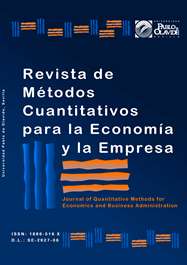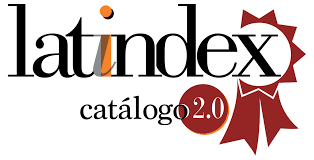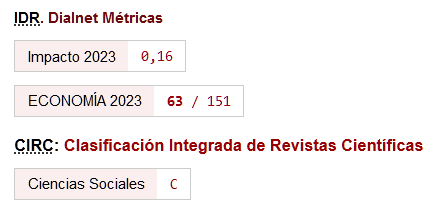Comparative analysis of multivariate capacity indicators. The case of the Cartagena manufacturing cluster
DOI:
https://doi.org/10.46661/revmetodoscuanteconempresa.2961Keywords:
multivariate analysis, principal component analysis, manufacturing cluster, capacity index, statistical process controlAbstract
Multivariable capacity index have been used frequently in the manufacturing industry and similar environments, since they provide quantitative measurements of the potential and performance of a process described by multiple quality characteristics susceptible to evaluation and correlated simultaneously. In this paper, we present an empirical evaluation of several approaches to analyze a multivariate industrial process. In the firs approach we study relationship of the volume of the tolerance region and the volume of the process region. In the second approach, we propose the application of principal components technique and, finally, we propose the application of other indicators that analyze the proportion of observations located outside the specification margins and their variability in the long and short term. The results provided indicate that analyzed production process is not marginally capable for satisfying predefined technical specifications and that there is a high margin of improvement.
Downloads
References
Caicedo, N., Jiménez, E., Vélez, S., & Wilches, M. (2015). Metodología para cálculo de un indicador de capacidad de procesos multivariado para sistemas de gestión integrados. Revista Universitaria RUTA, 17(1), 21-30.
Cuamea, G., & Rodriguez, M. (2014). Propuesta para evaluar la capacidad de procesos de manufactura multivariados. Ingeniería Industrial, 13(2), 35-47.
Dharmasena, L., & Zeephongsekul, P. (2015). A new process capability index for multiple quality characteristics based on principal components. International Journal of Production Research, 54(15), 1-17.
Hernández, C., & Da Silva, F. (2016). Aplicación del control estadístico de procesos (CEP) en el control de su calidad. Tecnología Química, 36(1), 104-116.
Herrera, J., Herrera, G., & Rahmer, B. (2017). Control Estadístico de Procesos para datos Correlados Serialmente. Un Caso de Estudio. International Conference on Industrial Engineering and Operations Management, (pp. 891-904). Bogotá.
Lea, W., Wu, C., & Wu, C. (2015). Estimating process capability index Cpk: classical approach versus Bayesian approach. Journal of Statistical Computation and Simulation, 85(10), 2007-2021.
Novaes, A. G., Lima Jr, O., Carvalho, C.C., & Aragão Jr, D.P. (2015). Process capability index Cpk for monitoring the thermal performance in the distribution of refrigerated products. Production, 26(1), 54-65.
Salazar, E., & Fermín, J. (2016). Un índice de capacidad de procesos para distribuciones multivariadas normales de variables correlacionadas y no correlacionadas. Ingeniería Industrial(34), 57-73.
Santos-Fernández, E. (2012). Multivariate Statistical Quality Control Using R. New York: Springer.
Santos-Fernández, E., & Scagliarini, M. (2012). MPCI: An R Package for Computing Multivariate Process Capability Indices. Journal of Statistical Software, 47(7), 1-15.
Vásquez , M., Ramírez, G., & García, T. (2016). Un ´ındice de capacidad multivariante basado en la probabilidad de no conformidad, una aplicacion al monitoreo de calidad de un ciclo de agua clarificada. Revista Ingeniería UC, 23(3), 319-326.
Verbel, A., Herrera, R., & Maestre, K. (2016). Aplicación de nuevas propuestas multivariantes para medir la capacidad de un proceso. Ingeniare(21), 33-44.
Wang, F.-K. (2014). Multivariate Process Capability Indices, Comparison of. Wiley StatsRef: Statistics Reference Online.
Zhang, M., Wang G, A., He, S., & He, Z. (2014). Modified Multivariate Process Capability Index Using Principal Component Analysis. Chinese Journal of Mechanichal Engineering, 27(2), 249-259.
Downloads
Published
How to Cite
Issue
Section
License
Copyright (c) 2020 Journal of Quantitative Methods for Economics and Business Administration

This work is licensed under a Creative Commons Attribution-ShareAlike 4.0 International License.
Submission of manuscripts implies that the work described has not been published before (except in the form of an abstract or as part of thesis), that it is not under consideration for publication elsewhere and that, in case of acceptance, the authors agree to automatic transfer of the copyright to the Journal for its publication and dissemination. Authors retain the authors' right to use and share the article according to a personal or instutional use or scholarly sharing purposes; in addition, they retain patent, trademark and other intellectual property rights (including research data).
All the articles are published in the Journal under the Creative Commons license CC-BY-SA (Attribution-ShareAlike). It is allowed a commercial use of the work (always including the author attribution) and other derivative works, which must be released under the same license as the original work.
Up to Volume 21, this Journal has been licensing the articles under the Creative Commons license CC-BY-SA 3.0 ES. Starting from Volume 22, the Creative Commons license CC-BY-SA 4.0 is used.










